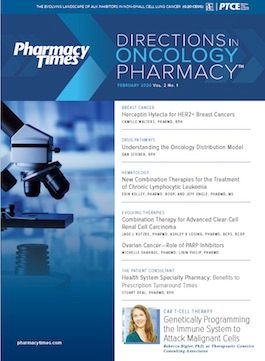Publication
Article
Pharmacy Practice in Focus: Oncology
Triple-Negative Breast Cancer: Improved Outcomes and Providing Patient-Centered Care
Melissa B. Armitage, PharmD, BCOP, a clinical pharmacist who works in breast oncology at the Moffitt Cancer Center in Tampa, Florida, discussed this disease's pathophysiology, natural progression, and risk factors.
Metastatic triple-negative breast cancer (TNBC) is a devastating diagnosis. This is a topic of considerable interest to oncology pharmacists because breast cancer is 1 of the 2 most common cancers in the world. In the United States, 269,000 new cases will be diagnosed in 2019 and approximately 42,000 people will die from this disease. For that reason, this was a well-attended session at the 2019 Directions in Oncology Pharmacy conference.
Melissa B. Armitage, PharmD, BCOP, a clinical pharmacist who works in breast oncology at the Moffitt Cancer Center in Tampa, Florida, discussed this disease’s pathophysiology, natural progression, and risk factors. She provided ample coverage of clinical and safety evidence that supports current and emerging therapies. She also covered strategies that optimize medication therapy for patients receiving a diagnosis of TNBC.
Dr. Armitage introduced TNBC by giving a brief overview of the American Society of Clinical Oncology and College of American Pathologists definitions and guidelines. Individuals who have this subtype of breast cancer are estrogen receptor negative, progesterone receptor negative, and human epidermal growth factor receptor 2 negative. Accounting for approximately 15% of breast cancers, TNBC is more common in women who are younger than 40 years, possess a BRCA mutation, and are black, obese, and/or premenopausal.
Usually TNBC presents as a high-grade infiltrating ductal carcinoma and almost all are grade 3 tumors. TNBC is significantly more aggressive than any other breast cancer. It is chemotherapy sensitive, but its victims have a median overall survival of approximately 13 to 18 months with standard chemotherapy. This certainly has put pressure on researchers and oncologists to find new and better ways to treat it. Interestingly, the risk of late recurrence is very low. In patients who have no recurrence over 5 years, relapse-free survival is 91% at 10 years.
Oncologists are using a number of different therapies for this aggressive disease. In some cases, sequential single-agent chemotherapy is preferred, and it is used in most women. If a rapid response is necessary, combination chemotherapy can be used but it carries the risk of increased adverse effects. Taxanes have been the foundation of cytotoxic chemotherapy approaches. Use of eribulin has been added to the armamentarium of cytotoxic therapies as well.
Dr. Armitage reviewed a number of different approaches and discussed the wide range of evolving targeted therapies that have gained recent recognition. These include poly ADP ribose polymerase (PARP) inhibitors, immune checkpoint inhibitors, and combination approaches of the same. PARP inhibitors, including olaparib and talazoparib, while having slightly different indications, are used in BRCA-mutated breast cancer. Each has shown a significant progression-free survival (PFS) benefit over standard chemotherapy and are relatively well tolerated. Results from the IMpassion130 Trial led to the first approval of an immune checkpoint inhibitor in this devastating disease. Atezolizumab in combination with nab-paclitaxel demonstrated a significantly improved PFS in both the overall and PD-L1 positive population. Severe (grade 3/4 adverse effects) were more common in the combination arm. She also discussed additional investigational agents for metastatic TNBC. In the pipeline are additional PARP inhibitors, the anti-TROP-2 antibody drug conjugate sacituzumab govitecan and the androgen receptor inhibitors, such as bicalutamide, enzalutamide, and abiraterone.
Education, chemotherapy selection, monitoring and managing adverse effects, and evaluating drug— drug and drug–disease interactions are critical. Dr. Armitage indicated that in TNBC, supportive care is an area where pharmacists can make a tremendous impact in patients’ lives. Nausea and vomiting, pain management, constipation and diarrhea, anemia, clotting disorders, and infection are serious concerns for which patients need considerable support.
With the increasing number of oral medications including PARP inhibitors used to treat TNBC, addressing adherence proactively is critical. Pharmacists can assist with prior authorization processes, letters of medical necessity, and appeals. Pharmacists should monitor for overadherence, which can amplify toxicities.
In conclusion, Dr. Armitage reminded pharmacists that the treatment goals are palliation and life prolongation. She reiterated the typical progression of treatment and the factors pharmacists need to consider while working with the multidisciplinary team.







